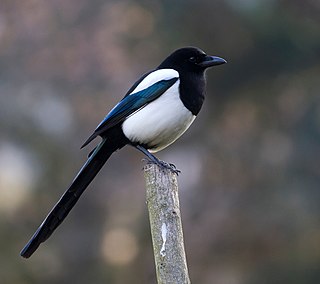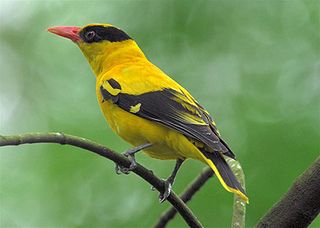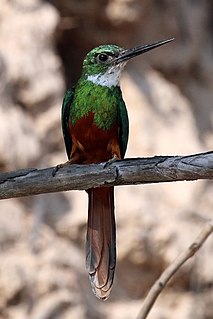
Magpies are birds of the Corvidae family. Like other members of their family, they are widely considered to be intelligent creatures. The Eurasian magpie, for instance, is thought to rank among the world's most intelligent creatures, and is one of the few non-mammal species able to recognize itself in a mirror test. They are particularly well known for their songs and were once popular as cagebirds. In addition to other members of the genus Pica, corvids considered as magpies are in the genera Cissa, Urocissa, and Cyanopica.

The bulbuls are members of a family, Pycnonotidae, of medium-sized passerine songbirds, which also includes greenbuls, brownbuls, leafloves, and bristlebills. The family is distributed across most of Africa and into the Middle East, tropical Asia to Indonesia, and north as far as Japan. A few insular species occur on the tropical islands of the Indian Ocean. There are 160 species in 32 genera. While different species are found in a wide range of habitats, the African species are predominantly found in rainforest, whereas Asian bulbuls are predominantly found in more open areas.
Old World warblers are a large group of birds formerly grouped together in the bird family Sylviidae. The family held over 400 species in over 70 genera, and were the source of much taxonomic confusion. Two families were split out initially, the cisticolas into Cisticolidae and the kinglets into Regulidae. In the past ten years they have been the subject of much research and many species are now placed into other families, including the Acrocephalidae, Cettiidae, Phylloscopidae, and Megaluridae. In addition some species have been moved into existing families or have not yet had their placement fully resolved. A smaller family of warblers, together with some babblers formerly placed in the family Timaliidae and the parrotbills, are retained in a much smaller family Sylviidae.

The Coraciiformes are a group of usually colourful birds including the kingfishers, the bee-eaters, the rollers, the motmots, and the todies. They generally have syndactyly, with three forward-pointing toes, though in many kingfishers one of these is missing. The members of this order are linked by their “slamming” behaviour, thrashing their prey onto surfaces to disarm or incapacitate them.

The Old World orioles (Oriolidae) are an Old World family of passerine birds.

Pica is the genus of seven species of birds in the family Corvidae in both the New World and the Old.

The diving ducks, commonly called pochards or scaups, are a category of duck which feed by diving beneath the surface of the water. They are part of Anatidae, the diverse and very large family that includes ducks, geese, and swans.

The genus Perisoreus is a very small genus of jays from the Boreal regions of North America and Eurasia from Scandinavia to the Asian seaboard. An isolated species also occurs in north-western Szechuan province of China. They belong to the Passerine order of birds in the family Corvidae. Not closely related to other birds known as jays, they are instead related to the genus Cyanopica.

The jacamars are a family, Galbulidae, of near passerine birds from tropical South and Central America, extending up to Mexico. The family contains five genera and 18 species. The family is closely related to the puffbirds, another Neotropical family, and the two families are often separated into their own order, Galbuliformes, separate from the Piciformes. They are principally birds of low-altitude woodlands and forests, and particularly of forest edge and canopy.

The puffbirds and their relatives in the near passerine family Bucconidae are tropical tree-dwelling insectivorous birds that are found from South America up to Mexico. Together with their closest relatives, the jacamars, they form a divergent lineage within the order Piciformes, though the two families are sometimes elevated to a separate order Galbuliformes. Lacking the iridescent colours of the jacamars, puffbirds are mainly brown, rufous or grey, with large heads, large eyes, and flattened bills with a hooked tip. Their loose, abundant plumage and short tails makes them look stout and puffy, giving rise to the English name of the family. The species range in size from the rufous-capped nunlet, at 13 cm (5.1 in) and 14 g (0.49 oz), to the white-necked puffbird, at up to 29 cm (11 in) and 106 g (3.7 oz).

Ovenbirds or furnariids are a large family of small suboscine passerine birds found from Mexico and Central to southern South America. They form the family Furnariidae. This is a large family containing around 315 species and 70 genera. The ovenbird, which breeds in North America, is not a furnariid – rather it is a distantly related bird of the wood warbler family, Parulidae.

The grey tit is a species of bird in the tit family Paridae. It is found in Lesotho and South Africa. Its natural habitats are subtropical or tropical dry shrubland and Mediterranean-type shrubby vegetation.

Parus is a genus of Old World birds in the tit family. It was formerly a large genus containing most of the 50 odd species in the family Paridae. The genus was split into several resurrected genera following the publication of a detailed molecular phylogenetic analysis in 2013. The genus name, Parus, is the Latin for "tit".

The ashy tit is a species of bird in the family Paridae. It is found in Angola, Botswana, Namibia, South Africa, and Zimbabwe. Its natural habitats are subtropical or tropical dry forests and dry savanna.

The dusky tit is a species of bird in the tit family Paridae. It is native to the African tropical rainforest.

The miombo tit is a species of bird in the family Paridae. It is found in Angola, Democratic Republic of the Congo, Malawi, Mozambique, Tanzania, Zambia, and Zimbabwe. Its natural habitat is subtropical or tropical dry forests.

The yellow-cheeked tit is a species of bird in the family Paridae.

Lecithocera is a genus of moths in the lecithocerid subfamily Lecithocerinae. The genus was erected by Gottlieb August Wilhelm Herrich-Schäffer in 1853.

Stigmella is a genus of moths of the family Nepticulidae. The genus was erected by Franz von Paula Schrank in 1802.

Bispira is a genus of marine bristleworm in the family Sabellidae. Its members were initially included in genus Sabella by Grube in 1851. In 1856, Krøyer described Bispira as a separate genus. Members of Bispira are defined by spirally-coiled, equally-divided branchial lobes.

















